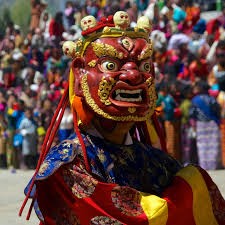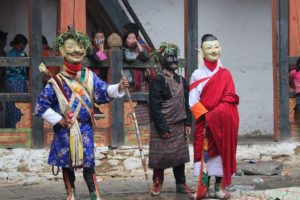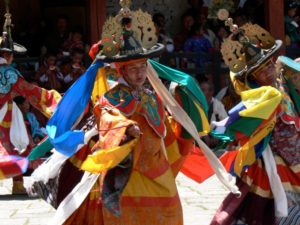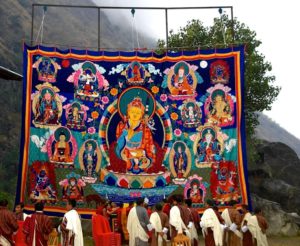
The blow of the horns overpowering the chirping of the birds and splash of hues in the otherwise green scenery marks the beginning of the most cherished festival of Bhutan, the Tsechu. Tsechu in Dzongkha literally means “the tenth day” as it is celebrated on the tenth day of a month of the lunar Tibetan calendar. It is celebrated across the nation with the month varying with each place. Though the Thimphu Tsechu celebrated in the fall and the Paro Tsechu celebrated in the spring are more popular due to the sheer number of participants. It is the religious festival of the Kagyu school of Tibetan Buddhism commemorating the life of Guru Rinpoche, the pioneer of Tibetan Buddhism in Bhutan, also known as the second Buddha or Padmasambhava and some other saints like Pema Lingpa who is only second to Guru Rinpoche in the history of Tibetan Buddhism.
It is usually held in the Dzongs or fortresses where the throng of people crowds from dawn break dressed in their best traditional attires. It is believed amongst the native people that attending the fest itself adds spiritual merits and wearing new clothes is another form of their offering to the deity. But along with the spiritual significance, this fest gives an opportunity for family get-togethers and picnics as well.

The highlight of the festival is the masked dance or Chams performed by monks. There are many dances recreating the different stages of Guru Rinpoche’s life story. The Dance of Three kinds of Gings brings good luck while the Dance of Heroes is believed to take the viewers to the presence of Guru Rinpoche himself. Another dance called the Dance of the Stag and the Hunter has a comedic strike along with the religious story of saint Milarepa converting a hunter, his dog, and his prey deer into Buddhism. While Dance of the Drametsi Drummers is a hypnotic performance with the monks dressed in animal masks dancing in circles to the beat of the drum recreating a disciple’s dream where he witnessed hundred peaceful and wrathful deities dancing in a similar manner, Raksha ma Cham is a popular favorite depicting the afterlife. And Guru Tshengay portrays different moods as it depicts the eight manifestations of Guru Rinpoche.

But the most important one, the Black Hat Dance is performed without any masks at all. Instead, the monks performing it wear heavy black hats carrying swords and shields clad in golden robes. It tells the story of Pelgyi Dorje, a student of Guru Rinpoche, and how he assassinated the ruthless Bon king Lang Dama after mysteriously appearing wearing a black hat. The dance mimics the twirls and spins that he performed before drawing a bow from his dark robe and shooting the King in the eye. This dance signifies the killing of another human being for the greater good.

Amidst the chams are performed the folk songs and dances calling on clusters of performers just by the strum of the Bhutanese guitar or the Dramyin. These narrate the tales of the common men like farming and welcoming new culture. Along with these, the Atsara, or the enlightened clowns, too make an appearance entertaining the crowds with their sexual humor and blessings.
On the final day at dawn break, the appliqué scroll painting called Thongdel is unfurled featuring a portrait of Padmasambhava. It is believed that one glance of the painting cleanses the person from all his sins as its name itself suggests, “thong” meaning to see and “del” meaning to cleanse of sins. At sunrise, it is withdrawn from public exhibition packed away for another year and with it ends the fest of Bhutan but the spiritual experience stays with one forever.

